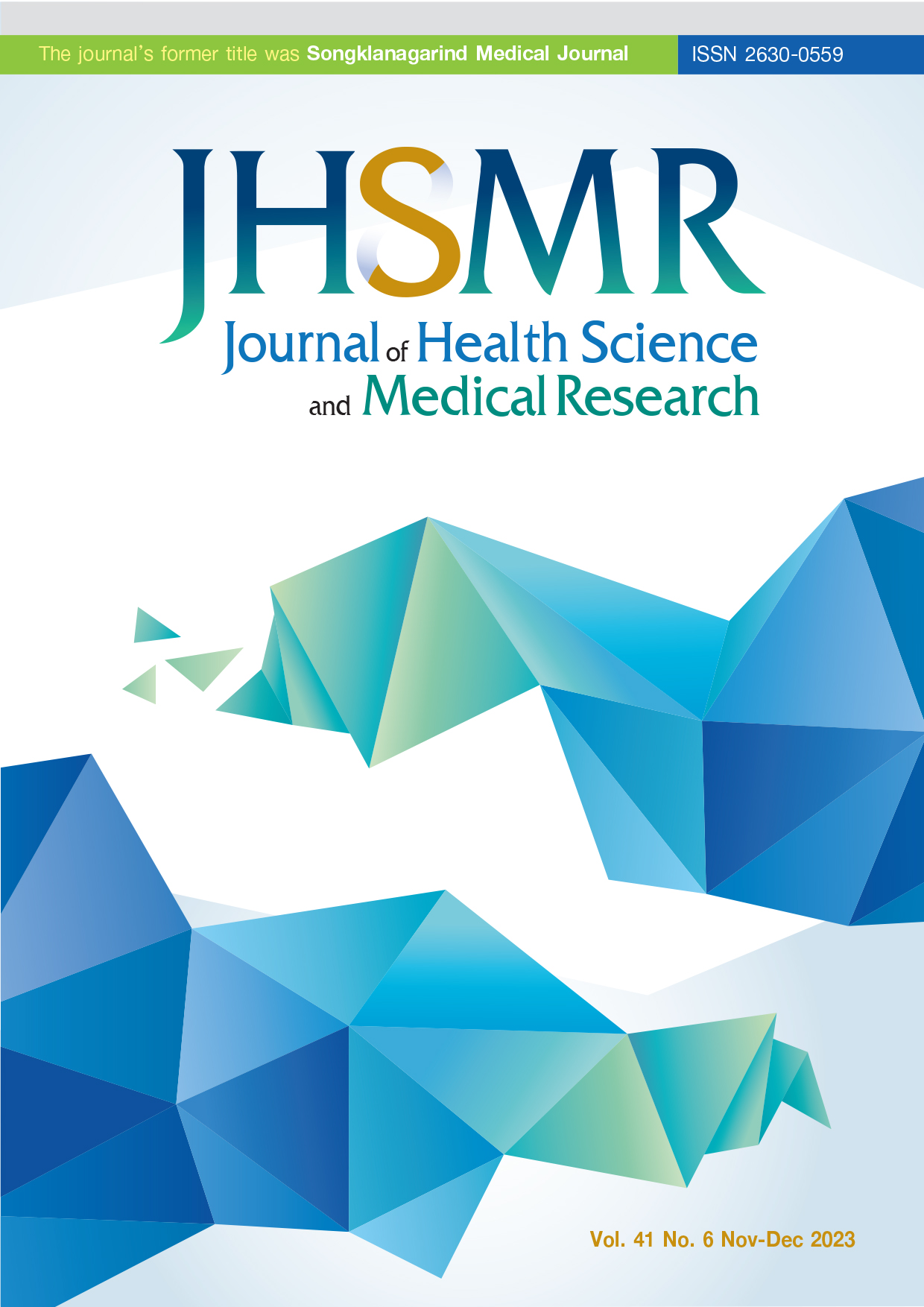Efficacy of Pilate’s Exercise with Postural Advice in the Management of Low Back Pain for Lower Limb Amputee Patients: A Randomised Control Trial
DOI:
https://doi.org/10.31584/jhsmr.2023966Keywords:
Pilate's exercise, postural advice, low back pain, lower limb amputeeAbstract
Objective: To observe the effectiveness of Pilate’s exercise, with postural advice to reduce low back pain for lower limb amputee patients.
Material and Methods: An assessor-blind, randomised control trial design has been used wherein sixty-two patients were divided into two groups by simple random allocation. The experimental group received the Pilates’ Training Program with postural advice, and the control group received usual care at the prosthetic department. There were thrity-one participants in both groups that completed the study. Both groups attended a 15-minute specialized, supervised session; 5 days a week, for 4 weeks. Outcomes were measured in terms of pain by a numeric pain rating scale and specific function & disability of the lumbo-pelvic region by the Roland-Morris Low Back Pain and Disability Questionnaire. Descriptive (median and inter quartile range, IQR) and inferential statistics (Pearson Chi-square test, Mann-Whitney U test and Wilcoxon Signed Rank Test) were performed to analyse the data through the Statistical Package for Social Sciences (SPSS), Windows version 25 (IBM, Armonk, NY, USA).
Results: Average age of participants was 33 (29.75 to 47.50) years; whereas, the average duration of amputationin the experimental group was 11 (7 to 13) months compared to 8 (6 to 11) months in the control group. Both groups showed significant improvement in terms of pain intensity and functional ability in intergroup analysis (p-value<0.05); additionally, in intra-group analysis participants that received Pilate’s exercise with postural advice had better outcomes than participants who received only postural advice (p-value<0.05).
Conclusions: It was concluded that Pilate’s exercise with postural advice is effective in the rehabilitation of patients with lower limb amputee-induced low back pain. Additionally, Pilate’s exercises with postural advice also led to better improvement in mechanical correction of the lumbo pelvic region.
References
Kim YC, Park CI, Kim DY, Kim TS, Shin JC. Statistical analysis of amputations and trends in Korea. Prosthet Orthot Int 1996; 20:88–95. doi: 10.3109/03093649609164424.
Chalya PL, Mabula JB, Dass RM, Ngayomela IH, Chandika AB, Mbelenge N, et al. Major limb amputations: A tertiary hospital experience in northwestern Tanzania. J Orthop Surg Res 2012; 7:18. doi: 10.1186/1749-799x-7-18.
Sansam K, Neumann V, O’Connor R, Bhakta B. Predicting walking ability following lower limb amputation: a systematic review of the literature. J Rehabil Med 2009; 41:593–603. doi: 10.2340/16501977-0393.
Rajasekaran S. The utility of scores in the decision to salvage or amputation in severely injured limbs. Indian J Orthop 2008; 42:368. doi: 10.4103/0019-5413.43371.
Gavan NA, Veresiu IA, Vinik EJ, Vinik AI, Florea B, Bondor CI. Delay between onset of symptoms and seeking physician intervention increases risk of diabetic foot complications: Results of a cross-sectional population-based survey. J Diabetes Res 2016; 2016:1–9. doi: 10.1155/2016/1567405.
Moxey PW, Gogalniceanu P, Hinchliffe RJ, Loftus IM, Jones KJ, Thompson MM, et al. Lower extremity amputations - a review of global variability in incidence. Diabet Med 2011;28:1144–53. doi: 10.1111/j.1464-5491.2011.03279.
Dua A, Patel B, Desai SS, Holcomb JB, Wade CE, Coogan S, et al. Comparison of military and civilian popliteal artery trauma outcomes. J Vasc Surg 2014;59:1628–32. doi: 10.1016/j. jvs.2013.12.037.
Friel K, Domholdt E, Smith DG. Physical and functional measures related to low back pain in individuals with lowerlimb amputation: an exploratory pilot study. J Rehabil Res Dev 2005;42:155. doi: 10.1682/jrrd.2004.08.0090.
Kulkarni J, Gaine WJ, Buckley JG, Rankine JJ, Adams J. Chronic low back pain in traumatic lower limb amputees. Clin Rehabil 2005;19:81–6. doi: 10.1191/0269215505cr819oa.
Ehde DM, Smith DG, Czerniecki JM, Campbell KM, Malchow DM, Robinson LR. Back pain as a secondary disability in persons with lower limb amputations. Arch Phys Med Rehabil 2001;82:731–4. doi: 10.1053/apmr.2001.21962.
Highsmith MJ, Goff LM, Lewandowski AL, Farrokhi S, Hendershot BD, Hill OT, et al. Low back pain in persons with lower extremity amputation: a systematic review of the literature. Spine J 2019;19:552–63. doi: 10.1016/j.spinee.2018.08.011
Gatchel RJ, McGeary DD, McGeary CA, Lippe B. Interdisciplinary chronic pain management: past, present, and future. Am Psychol 2014;69:119–30. doi: 10.1037/a0035514.
Manchikanti L, Singh V, Falco FJE, Benyamin RM, Hirsch JA. Epidemiology of low back pain in adults. Neuromodulation 2014;17:3–10. doi: 10.1111/ner.12018.
Hill E. Mechanical low back pain: practice essentials, background, pathophysiology [homepage on the Internet]. New York: Medscape; 2018 [cited 2022 Sep 25]. Available from: https://emedicine.medscape.com/article/310353-clinical.
Rydeard R, Leger A, Smith D. Pilates-based therapeutic exercise: Effect on subjects with nonspecific chronic low back pain and functional disability: a randomized controlled trial. J Orthop Sports Phys Ther 2006;36:472–84. doi: 10.2519/jospt. 2006.2144
Adams M, Caldwell K, Atkins L, Quin R. Pilates and mindfulness: a qualitative study. J Dance Edu 2012;12:123-30. doi: 10.1080/15290824.2012.636222.
Pilates JH, Miller WJ. Guiding principles of pilates. Pilates for Rehab 2019; doi: 10.5040/9781718209572.ch-002.
Muscolino JE, Cipriani S. Pilates and the “powerhouse” I. J Bodyw Mov Ther 2004;8:15–24. doi: 10.1016/s1360-8592(03)00057-3.
Bliss LS, Teeple P. Core stability. Curr Sports Med Rep 2005;4:179–83. doi: 10.1097/01.csmr.0000306203.26444.4e.
Gladwell V, Head S, Haggar M, Beneke R. Does a program of pilates improve chronic non-specific low back pain? J Sport Rehabil 2006;15:338–50. doi: 10.1123/jsr.15.4.338.
Haefeli M, Elfering A. Pain assessment. Eur Spine J. 2005;15:S17-24. doi: 10.1007/s00586-005-1044-x.
Stratford PW, Riddle DL. A roland morris disability questionnaire target value to distinguish between functional and dysfunctional states in people with low back pain. Physiother Can 2016;68:29–35. doi: 10.3138/ptc.2014-85.
Hestbaek L, Iachine IA, Leboeuf-Yde C, Kyvik KO, Manniche C. Heredity of low back pain in a young population: a classical twin study. Twin Res 2004;7:16–26. doi: 10.1375/13690520460741408
Miyamoto GC, Costa LO, Cabral CM. Efficacy of the pilates method for pain and disability in patients with chronic nonspecific low back pain: a systematic review with metaanalysis. Braz J Phys Ther 2013;17:517–32. doi: 10.1590/s1413-35552012005000127.
Asgari Ashtiani A, Askari A. Effects of modified pilates exercises on pain, disability, and Lumbopelvic Motor Control in patients with chronic low back pain. PTJ 2020;10:195–204. doi: 10.32598/ptj.10.4.72.5.
Rainville J, Hartigan C, Martinez E, Limke J, Jouve C, Finno M. Exercise as a treatment for chronic low back pain. Spine J 2004;4:106–15. doi: 10.1016/s1529-9430(03)00174-8.
Gladwell V, Head S, Haggar M, Beneke R. Does a program of Pilates improve chronic non-specific low back pain? J Sport Rehabil. 2006;15:338-50. doi: 10.1123/jsr.15.4.338.
Phrompaet S, Paungmali A, Pirunsan U, Sitilertpisan P. Effects of pilates training on Lumbo-pelvic stability and flexibility. Asian J Sports Med 2011;2:16. doi: 10.5812/asjsm.34822.
França FR, Burke TN, Hanada ES, Marques AP. Segmental stabilization and muscular strengthening in chronic low back pain - a comparative study. Clinics 2010;65:1013–7. doi: 10.1590/s1807-59322010001000015.
Rasmussen-Barr E, Äng B, Arvidsson I, Nilsson-Wikmar L. Graded exercise for recurrent low-back pain. Spine. 2009;34:221–8. doi: 10.1097/brs.0b013e318191e7cb.
Hassan EA, Amin MA. Pilate’s exercises influence on the serotonin hormone, some physical variables and the depression degree in battered women. World J Sports Sci 2011;5:89-100.
Norris CM. Functional load abdominal training: part 1. Phys Ther Sport 2001;2:29–39. doi: 10.1054/ptsp.2000.0032.
Mallin G, Murphy S. The effectiveness of a 6-week pilates programme on outcome measures in a population of chronic neck pain patients: a pilot study. J Bodyw Mov Ther 2013;17:376–84. doi: 10.1016/j.jbmt.2013.03.003.
Downloads
Published
How to Cite
Issue
Section
License

This work is licensed under a Creative Commons Attribution-NonCommercial-NoDerivatives 4.0 International License.
























